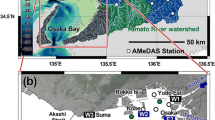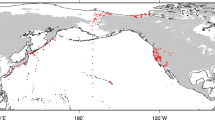Abstract
The evolution in time and space of terrestrial runoff in waters of the Mesoamerican region was examined using remote sensing techniques combined with river discharge and numerical ocean circulation models. Ocean color SeaWiFS images were processed using a new Spectral Optimization Algorithm for atmospheric correction and ocean property retrieval in Case-2 waters. A total of 157 SeaWiFS images were collected between 1997 and 2006 and processed to produce Colored Detrital Material images of the Mesoamerican waters. Monthly terrestrial runoff load and river discharge computed with a land-elevation model were used as input to a numerical model, which simulated the transport of buoyant matter from terrestrial runoff. Based on land cover for years 2003–2004, modeling results showed that the river discharge seasonality was correlated with the image averaged CDM, and the simulated plume reproduces the spatial patterns and temporal evolution of the observed CDM plume. River discharge peaked in August and CDM peaked from September to January. The buoyant matter concentration was high from October to January, and was at its lowest from March to April. Between October and December the plume was transported out of the Mesoamerican waters by a cyclonic gyre located north of Honduras. Part of the runoff from Honduras was transported towards Chinchorro Banks and the Yucatan Channel, part re-circulated into the Gulf of Honduras, and part taken toward the outside of the Mesoamerican Barrier Reef System. This study shows that all the reefs of the MBRS, including the most offshore atolls of the region, are under the influence of terrestrial runoff on a seasonal basis, with maximum effect during October to January, and minimum from March to April. Furthermore, what is seen as a giant plume in satellite images is in fact composed of runoffs of different ages.














Similar content being viewed by others
References
Andréfouët S, Mumby PJ, McField M, Hu C, Muller-Karger FE (2002) Revisiting coral reef connectivity. Coral Reefs 21:43–48
Blaas M, Dong C, Marchesiello P, McWilliams JC, Stolzenbach KD (2007) Sediment-transport modeling on Southern California shelves: a ROMS case study. Cont Shelf Res 27:832–853
Burke L, Sugg Z (2006) Hydrologic modeling of watersheds discharging adjacent to the Mesoamerican Reef. On the watershed analysis for the Mesoamerican Reef, WRI/ICRAN. http://www.wri.org/biodiv/pubs_description.cfm?pid=4256
Devlin MJ, Brodie J (2005) Terrestrial discharge into the great barrier reef lagoon: nutrient behavior in coastal waters. Mar Pollut Bull 51:9–22
Durand N, Fiandrino A, Fraunie P, Ouillon P, Forget P, Naudin JJ (2002) Suspended matter dispersion in the Ebro ROFI: an integrated approach. Cont Shelf Res 22:267–284
Ezer T, Thattai DV, Kjerfe B, Heyman WD (2005) On the variability of the low along the Meso-American barrier reef system: a numerical model study of the influence of the Caribbean current eddies. Ocean Dynam 55:458–475
Garver SA, Siegel DA (1997) Inherent optical property inversion of ocean color spectra and its biogeochemical interpretation: 1 time series from the Sargasso Sea. J Geophys Res 102:18607–18625
Gordon HR, Wang M (1994) Retrieval of water-leaving radiance and aerosol optical thickness over the oceans with SeaWiFS: a preliminary algorithm. Appl Optics 33:443–452
Heyman WD, Kjerfe B (2000) The Gulf of Honduras. In: Seelijer U, Kjerfe B (eds) Coastal marine ecosystems. Marine ecosystems of Latin America. Springer, Berlin, pp 17–32
Huthnance JM (2004) Ocean to shelf signal transmission: a parameter study. J Geophys Res 109:C12029. doi:10.1029/2004JC002358
Jorgensen PV, Edelvang K (2000) CASI data utilized fro mapping suspended matter concentrations in sediment plumes and verification of 2D hydrodynamic modeling. Int J Remote Sens 21:2247–2258
Kleypas JA, Buddemeier RW, Gattuso JP (2001) The future of coral reefs in an age of global change. Int J Earth Sci 90:426–437
Luick JL, Mason L, Hardy T, Furnas MJ (2007) Circulation in the great barrier reef lagoon using numerical tracers and in situ data. Cont Shelf Res 27:757–778
Magnuson A, Harding LW Jr, Mallonee ME, Adolf JE (2004) Bio-optical model for Chesapeake Bay and the middle Atlantic bight. Estuar Coast Shelf Sci 61:403–424
Maritorena S, Siegel DA, Peterson AR (2002) Optimization of semi-analytical ocean color model for global scale applications. Appl Optics 41:2705–2714
McClanahan T, Muthiga N (1998) An ecological shift in a remote coral atoll of Belize over 25 years. Environ Conserv 25:122–130
McKergow LA, Prosser IP, Hughes AO, Brodie J (2005) Regional scale nutrient modeling: exports to the Great Barrier Reef world heritage area. Mar Pollut Bull 51:186–199
O’Reilly JE, Maritorena S, Mitchell BG, Siegel DA, Carder KL, Garver SA, Kahru M, McClain C (1998) Ocean color chlorophyll algorithms for SeaWiFS. J Geophys Res 103:24937–24953
Ouillon S, Douillet P, Andréfouët S (2004) Coupling satellite data with in situ measurements and numerical modeling to study fine suspended-sediment transport: a study for the lagoon of New Caledonia. Coral Reefs 23:109–122
Richardson PL (2005) Caribbean Current and eddies as observed by surface drifters. Deep Sea Res II 52:429–463
Sheng J, Wang L, Andréfouët S, Hu C, Hatcher BG, Muller-Karger FE, Kjerfe B, Heymans WD, Yang B (2007) Upper ocean response of the Mesoamerican barrier reef system to hurricane Mitch and coastal freshwater inputs: a study using SeaWiFS ocean color data and a nested-grid ocean circulation model. J Geophys Res 112:C07016. doi:10.1029/2006JC003900
Spalding M, Ravilious C, Green EP (2001) World atlas of coral reefs. University of California Press, Berkeley
Tang L, Sheng J, Hatcher BG, Sale PF (2006) Numerical study of circulation. Dispersion, and hydrodynamic connectivity of surface waters on the Belize shelf. J Geophys Res 111:C01003. doi:10.1029/2005JC002930
Wilkinson CR (1987) Interocean differences in size and nutrition of oral reef sponge populations. Science 236:1654–1657
Wilkinson CR (1999) Global and local threats to coral reef functioning and existence: review and predictions. Mar Freshw Res 50:867–878
Acknowledgments
This MAR modeling project was jointly funded by the World Resources Institute (WRI) and The Nature Conservancy (TNC). The authors are grateful to Lauretta Burke (WRI), Nestor Vindevoxhel (TNC) and Alejandro Arrivillaga (TNC) for providing the funding; to Villy Kourafalou for sharing computer resources at the Rosenstiel School of Marine and Atmospheric Sciences (RSMAS) for this project, and to Johnathan Kool (RSMAS) for technical assistance with GIS processing. C.Paris was also funded by the World Bank/GEF Coral Reef Target Research Program.
Author information
Authors and Affiliations
Corresponding author
Additional information
Communicated by Biology Editor M.P. Lesser.
Appendix
Appendix
River water transported to the oceans can be thought of as being made up of, in addition to water, a number of components:
-
1.
PIC (Particulate Inorganic Carbon) = Al, Fe, Si, Ca, K, Mg, Na and P. Alternate names: suspended inorganic matter; sediment. The terms sediment is ambiguous. It implies deposition which is dependent on velocity, density and salinity.
-
2.
Dissolved major species, comprising elements with no gaseous phase in the atmosphere (e.g., Cl−, Na+, HCO3−, Mg2+, K+) and elements with gaseous phases (e.g., SO 2−4 , HCO −3 ), with the latter derived from atmospheric gases (egg., SO2 and CO2, respectively), as well as from rocks.
-
3.
Dissolved nutrient elements N, P (and sometimes Si), which are used biologically and whose concentrations vary due to this.
-
4.
DOC (Dissolved Organic Carbon). Alternate name: dissolved organic matter. This is primarily sourced from soils and plants.
-
5.
POC (Particulate Organic Carbon) = phytoplankton and detritus (plant material). Alternate name: suspended organic matter.
-
6.
Dissolved trace metals.
-
7.
Suspended trace metals.
From the above list, Suspended Particulate Matter (SPM) will contain PIC, POC and suspended trace metals, the suspended terms.
Buoyant Matter will contain ALL terms; however the amount of PIC will depend on the rate of deposition and re suspension from the source.
The ROMS model will invariably replicate the transport of Buoyant Matter.
The SOA model produces CDM, the absorption coefficient of Colored Detrital Material. This is comprised of two components
-
1.
The absorption coefficient of colored dissolved organic matter (CDOM), one component of DOC.
-
2.
The absorption coefficient of detrital particles, one component of POC.
Therefore the spatial and temporal trends in CDM can be used as a surrogate for Buoyant Matter.
Rights and permissions
About this article
Cite this article
Chérubin, L.M., Kuchinke, C.P. & Paris, C.B. Ocean circulation and terrestrial runoff dynamics in the Mesoamerican region from spectral optimization of SeaWiFS data and a high resolution simulation. Coral Reefs 27, 503–519 (2008). https://doi.org/10.1007/s00338-007-0348-1
Received:
Revised:
Accepted:
Published:
Issue Date:
DOI: https://doi.org/10.1007/s00338-007-0348-1




